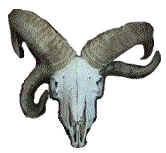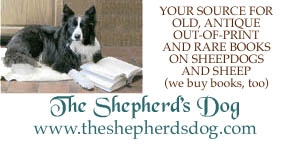HOME | home
Scottish Blackface | Scottish Blackface II | Scottish Blackface III | Scottish Blackface IV | Scottish Blackface VI | Scottish Blackface VII | Scottish Blackface V | Scottish Blackface VIII | Blackface IX | Blackface X | Scottish Blackface Breeders Guild | Blackface Guild 2 | Sheep Shearing | Photo Essay of Blackface | Piebald or Jacob Sheep | Soay Sheep | The Shepherds Bothy
Piebald or Jacob Sheep
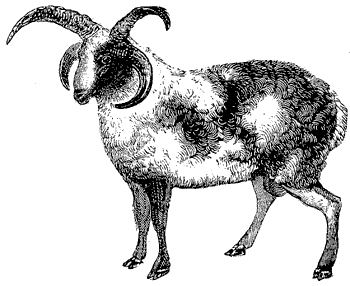
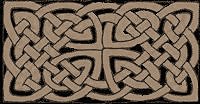
A rare olde breed
with distinct color and horn patterns
Jacobs were probably first imported to Canada and the United States as zoo animals due to their exotic appearance, but records are scarce. Some individuals acquired Jacob sheep from zoos around the 1960s, but the breed remained very rare in North America for several decades. Identification of the breed as endangered and ensuing registration of sheep began in 1985.
Jacob sheep are hardy animals with high resistance to parasites and disease. Hooves generally only need trimming once a year, even on soft pasture, and sheep only need shearing once a year. Jacobs are seasonal breeders and twins are common.
Jacobs do not need supplemental grain. Feeding grain during pregnancy can cause birth complications. Adequate pasture, hay, and loose minerals (formulated for sheep, not cattle) fulfill the Jacob's nutritional needs. Shelter from rain and weather is needed, but the shelter can be open and simple.
The wool of the Jacob sheep varies with the animal in question. In general, Jacobs have open fleeces weighing no more than about five pounds and of medium-fine quality. The fleece of a Jacob feels somewhat springy. Many Jacobs have some kemp (coarse, hair-like fibers) in their wool, which is natural for primitive breeds, but excessive kemp throughout the fleece is considered undesirable. Quality of wool often ranges from flock to flock.
Jacobs are shorn once a year. Some individual sheep will show a natural "break" in the fleece in springtime, which sometimes leads to a natural shedding of the fleece, particularly around the neck and shoulders. The wool is sought after by handspinners.
In some sheep (particularly British Jacobs, which have denser fleeces), the black wool will grow longer or shorter than the white wool. This is called "quilted fleece" and is an undesirable trait.
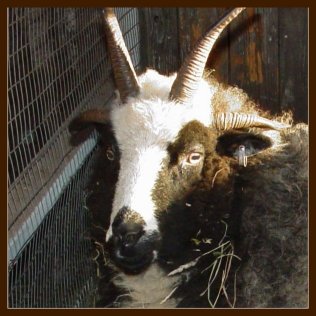
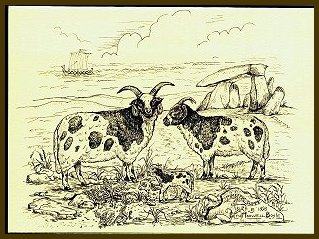
Piebald or Jacob Sheep are an English Breed with a Scandinavian Background. They are descendants of the sheep the Norse traveled the Seas with as they sought new lands to colonize!
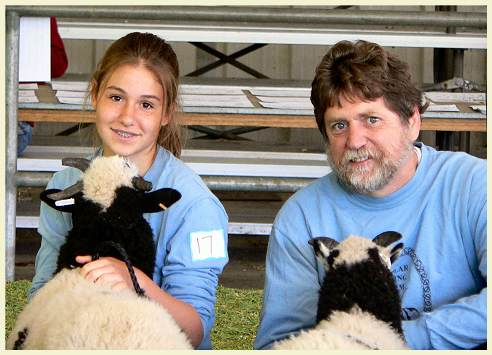
Short Video
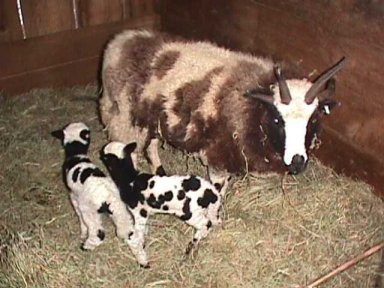
Two Horn and four horn ewe lambs out a four horn ewe
Photo By James E. Boyle
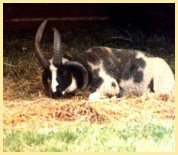
Four Horn Ram,
1974 Fairyland Forest Conneaut Lake, PA
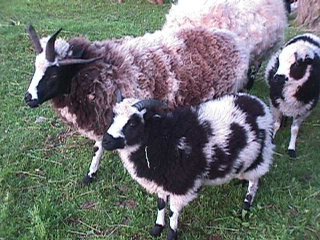
Ewes at Thistledown Croft
Certain faults in Jacobs show that there is blood of another breed in the mix. This is considered disqualifying from all US registries since the hope is to preserve a distinct breed of very old lineage. One of the most obvious signs of cross breeding is white horns. Likewise solid black animals that have mostly black wool. There is a fairly wide range of variation and progeny testing is a very good way to insure your stock will breed true to breed type. There are allot of crossbreds out there being sold as purebreds so buyer beware!
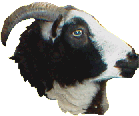
From an 1860 Encyclopedia
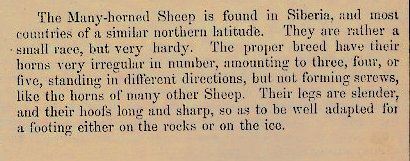
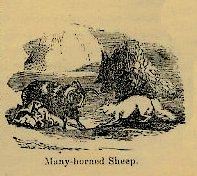
It is myth that Jacobs are related to the fat tailed sheep of the Middle East
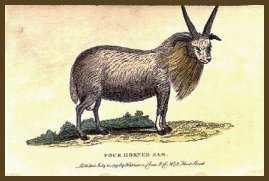
18th Century Four Horn Ram
Jacobs can have two four and can even have more horns. They have a spotted or piebald fleece which is genetically black with white spotting. The legs should also have knee patches of black and or ankle spots. Horns can be black or striped but not pure white. Legs should not be all white either. These are breed standards and not every animal is perfect. The breeders hope is that the sheep he or she raises will come close to that ideal standard with as few serious faults as possible.
In the UK the Breed has been "improved" with Dorset and other Blood!
And they no longer resemble a primitive breed. They are bulky, much larger than those in the USA and no longer have the knee spots on most individuals. Most American breeders prefer the Jacob to remain more like the original smaller more feral looking examples common in the UK prior to the 70s. The beginnings of Jacob sheep preservation in the USA is closely associated with the ALBC and other groups wishing to preserve our livestock heritage. It is an entirely different emphasis than commercial sheep breeding. The UK has the Livestock Survival Trust but somehow they were unable to keep the Jacob from being commercialized to the point there are few flocks of old style Jacobs left. perhaps the Jacob in the UK is a victim of too much popularity. Other primitive breeds in the UK have faired better.
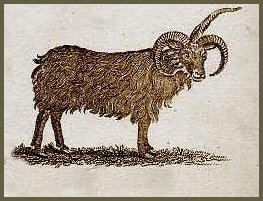
Click here to see the UK Breeders Organization,

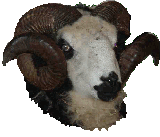
Other Breeds with four horns
However Romantic it may be the Jacob Sheep does not have a Biblical Connection other than the modern name. The closest relatives to Piebald sheep are the Hebridian and Manx Loghton sheep of the UK which are also four horned. Other close relatives are the Icelandic and Gotland Sheep. The Jacob has a tail that stops at the hocks, small eyes and small ears, all characteristics of a Northern breed not a Middle Eastern one. Middle Eastern and Eastern breeds have a broad flat tail that is very fatty.
These facts may not be politically correct with some Jacob breeders but it's good science not fairytale and fancy. Before it became desirable to have all white sheep for the purpose of dying, most early breeds came in black or were spotted like the Jacob Sheep. Jacobs survived principally as park sheep and were never "improved" like commercial breeds until recently in the UK. In the USA and Canada breeders prefer to preserve the genetics of this unique wool breed and have not introduced blood to make the breed bigger.
Many Nordic breeds also retain the wonderful colors and spots as the Jacob or Piebald sheep do. The name Piebald in fact means spotted! Shetland Sheep may also be distant relatives of the Jacob.With the high number of large commercial and improved sheep breeds it seems shear folly to change such and ancient and majestic creature as the Jacob Sheep to meet the demands of fashion and fancy. After all we are talking about animals that date back to the Viking age!
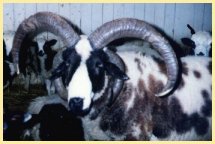
Breeder, Timothy Charles
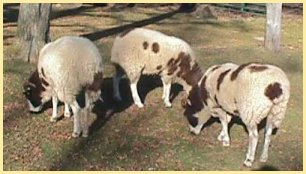
Ewes breed by Barking Rock Farm
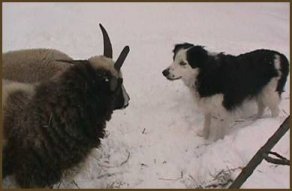
Facing off with the Border Collie
In recent times unenlightened breeders have put too much emphasis on perfect horns which is a dangerous trend in a rare breed with a limited gene pool. The horns on Jacobs often become distorted when broken and horn pattern genetics have not yet been adequately documented.
Shepherds Crooks USA
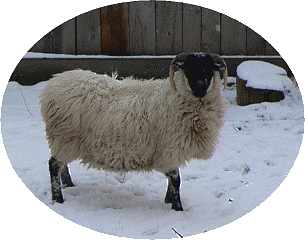
copyright 2002 , Jim & Beth Boyle, All Rights Reserved
No part of this website may be used for any purpose ( including using images )
without written consent from The Rams Horn
